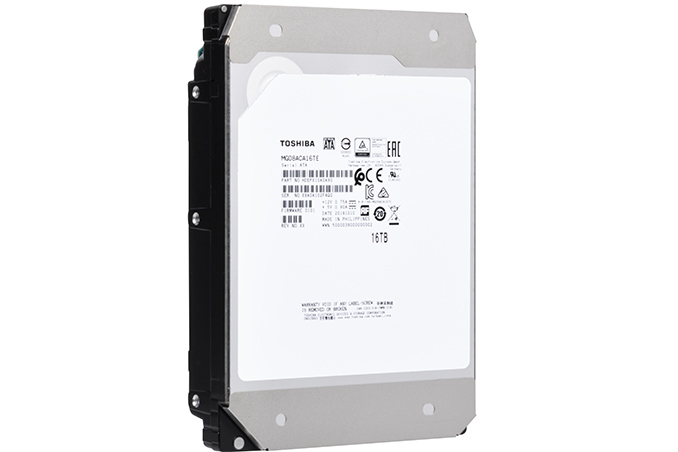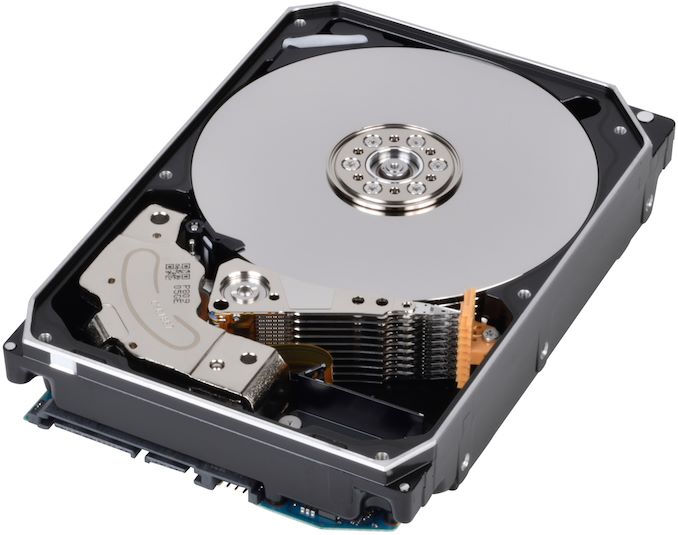Toshiba at CES 2019: World’s First 16 TB TDMR HDD Debuts
by Anton Shilov on January 9, 2019 5:00 PM EST
Toshiba has announced the industry’s first hard drive featuring a 16 TB capacity. The MG08-series HDDs are designed for nearline applications and use two-dimensional magnetic recording (TDMR) technology, therefore offering consistent and predictable performance.
Toshiba’s MG08 3.5-inch helium-filled hard drives rely on nine 1.7 TB PMR platters developed by Showa Denko K.K. (SDK) as well as 18 reader/writer TDMR heads designed by TDK. The HDD features a 7200 RPM spindle speed, a 512 MB DRAM buffer, and a SATA 6 Gbps or SAS 12 Gbps interface (depending on the model). Since the MG08 HDDs are aimed at nearline applications that use hundreds of hard drives per rack and are subject to severe vibrations, the HDDs feature top and bottom attached motors, RVFF as well as environmental sensors and other innovations designed to improve reliability and ensure consistent performance.
Just like other nearline HDDs from Toshiba, the new MG08-series supports the company’s persistent write cache (PWC) with power loss protection (PLP), which is crucial for 4K sector drives that emulate 512B sectors. The PWC with PLP feature protects data in case of power loss while performing a read-modify-write (RMW) operation to align the source write request with the physical sectors it has to modify. RMW enables Toshiba to address clients who run legacy systems with high capacity points.
Toshiba’s MG08 drives represent a number of industry firsts. First up, Toshiba is the only company in world to use a nine-platter HDD design. It was necessary with its 14 TB hard drives as the company did not use TDMR back then (unlike Seagate). Secondly, the MG08 uses SDK’s PMR platters featuring a 0.635 mm z-height, that’s down from 0.8 mm disks usually used for eight-platter designs. Thirdly, it uses TDMR heads developed by TDK, which enabled Toshiba to use the said platters.
Surprisingly, Toshiba does not disclose performance numbers for its latest drives (possibly because it is still polishing off their firmware), but it is logical to assume that the new HDDs are faster than their predecessors both in terms of sustained transfer rate as well as random read/write operations because of higher areal density, an enlarged cache and other factors.
Toshiba rates its MG08 HDDs for 550 TB average annualized workload, 2.5 million hours MTBF and covers them with a standard five-year warranty. It is going to take Toshiba’s partners four to six months to validate the new HDDs before deployment. Therefore, mass production of the MG08 hard drives will start several months from now.
Related Reading:
- Toshiba Launches 12 TB and 14 TB HDDs for Desktops and NAS
- Toshiba Announces 14 TB PMR MG07ACA HDD: 9 Platters, Helium-Filled, 260 MB/s
- Toshiba Launches MN06ACA 10 TB HDD for NAS: 7 Platters, Up to 249 MB/s
Source: Toshiba













7 Comments
View All Comments
CrazyElf - Wednesday, January 9, 2019 - link
First of all, it looks like it is not a big improvement in terms of overall areal density compared to the competition. The main cause of the high capacity is more platters (9 vs 8 on competing 14TB drives), although that is arguably an improvement of sorts.We will have to wait and see what the final numbers are like to see if they sacrificed any performance to achieve their storage capacity.
melgross - Friday, January 11, 2019 - link
As the article says, performance should be higher, not lower.jabber - Thursday, January 10, 2019 - link
Single platter version please! Obviously not at 16TB of storage but I'll take a 2TB single platter version of this tech.Storage Follower - Saturday, January 12, 2019 - link
I read a lot of storage articles so lets put some of their facts on here. Seagate are already deploying 16TB HAMR drives into OEM cloud customers. So the claim of Tosh being first is not justified. But if they use the spin of the first 16TB TDMR I suppose thats how they can make this claim. Misleading. Seagate are the capacity leaders with true deployment across multiple segments not just Enterprise and have been for while now. Their technology surpasses the others and shows the industry a path to 100tb on a 3.5", not to mention their Mach 2 multi actuator doubling HDD speeds. Only recently WD have released an article on this which is 2yrs behind Seagstes first annoucement. WD articles seem to question their $100 million investment into their MAMR and considering changing the focus onto HAMR so again this helps people realise maybe Seagate have got it bang on. In context Seagate have spent $2 billion on HAMR. You wouldnt spend that unless your certain of what is required for the future of data storage. They have had these units in deployment and stress tested for 3 years, they demo working drives at exhibitions the others do not when making these claims. Time will tell but if I was going to bet on who's right to keep in pace with all the technology advancements, Seagate would get my backing no question.